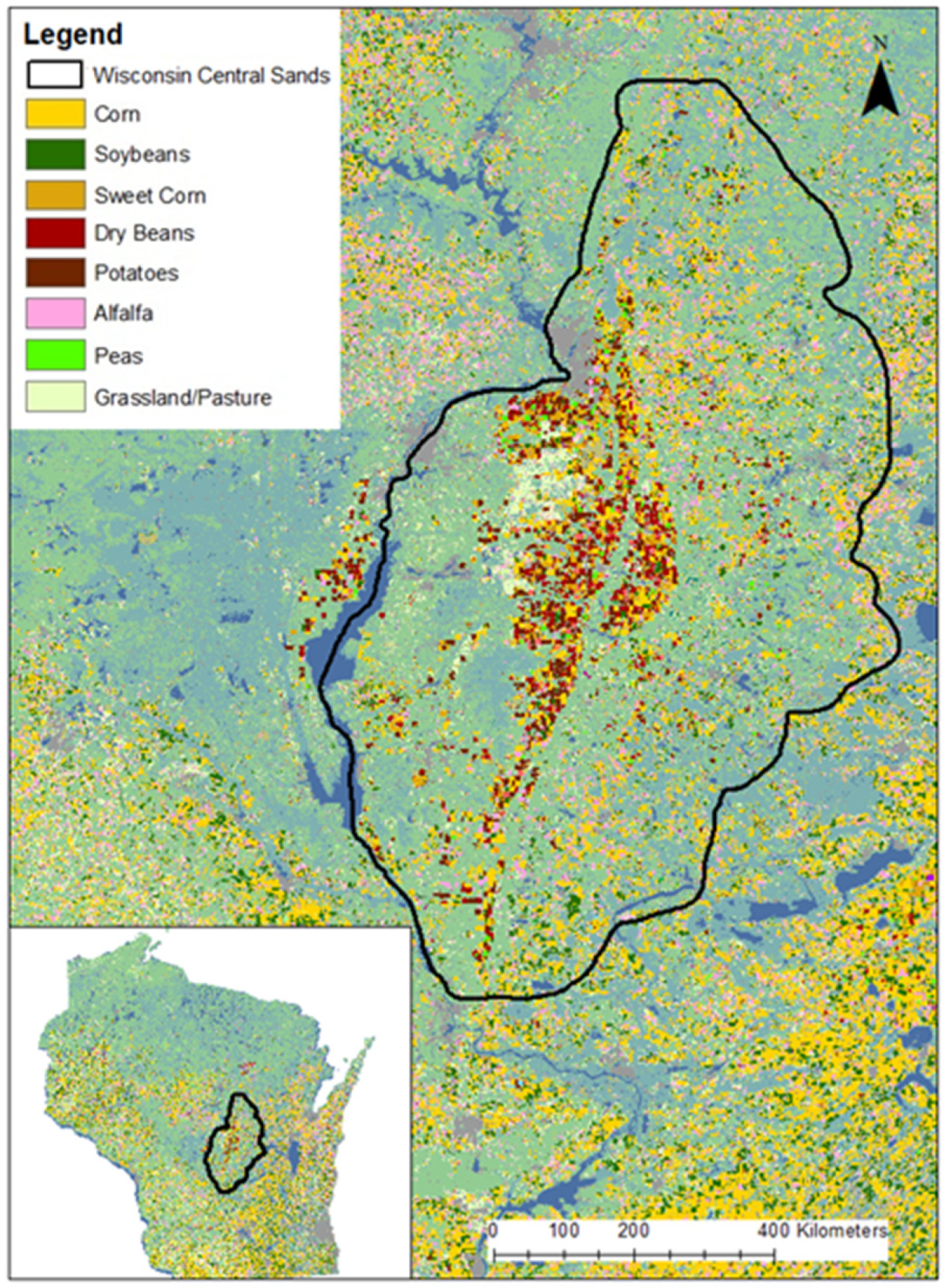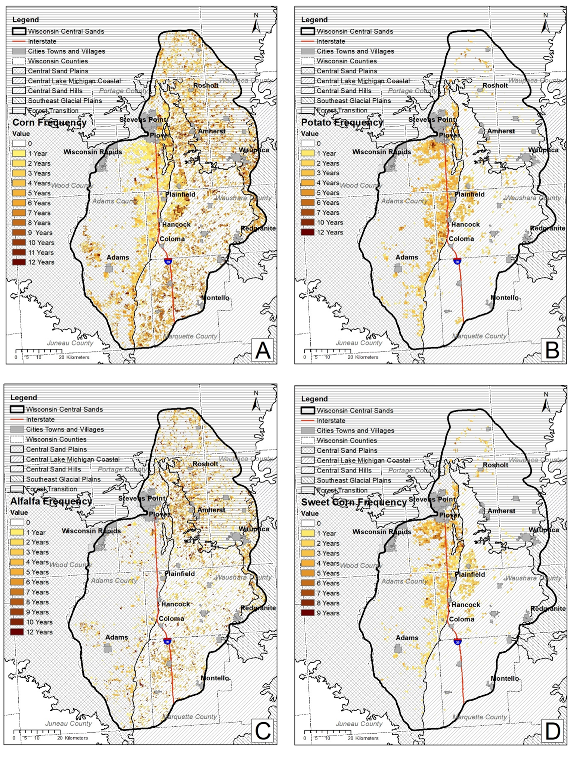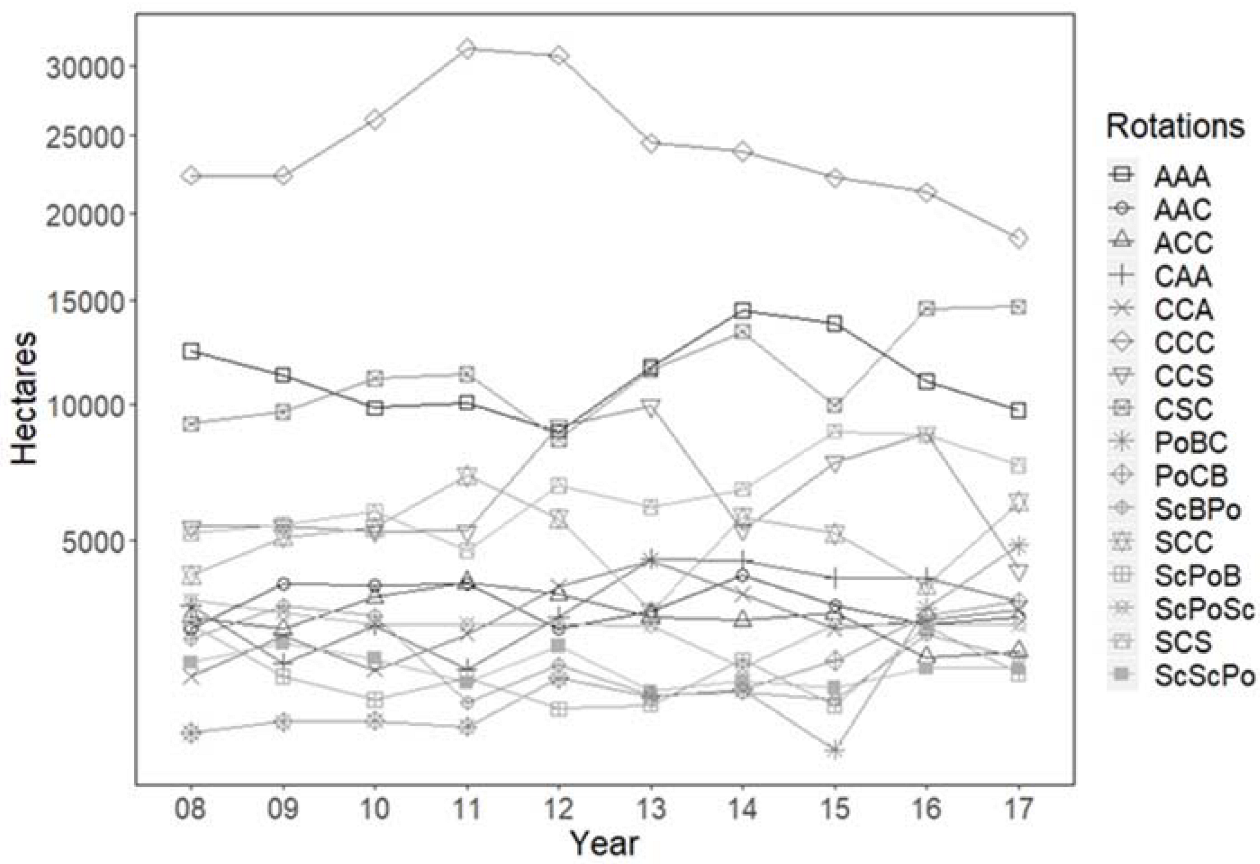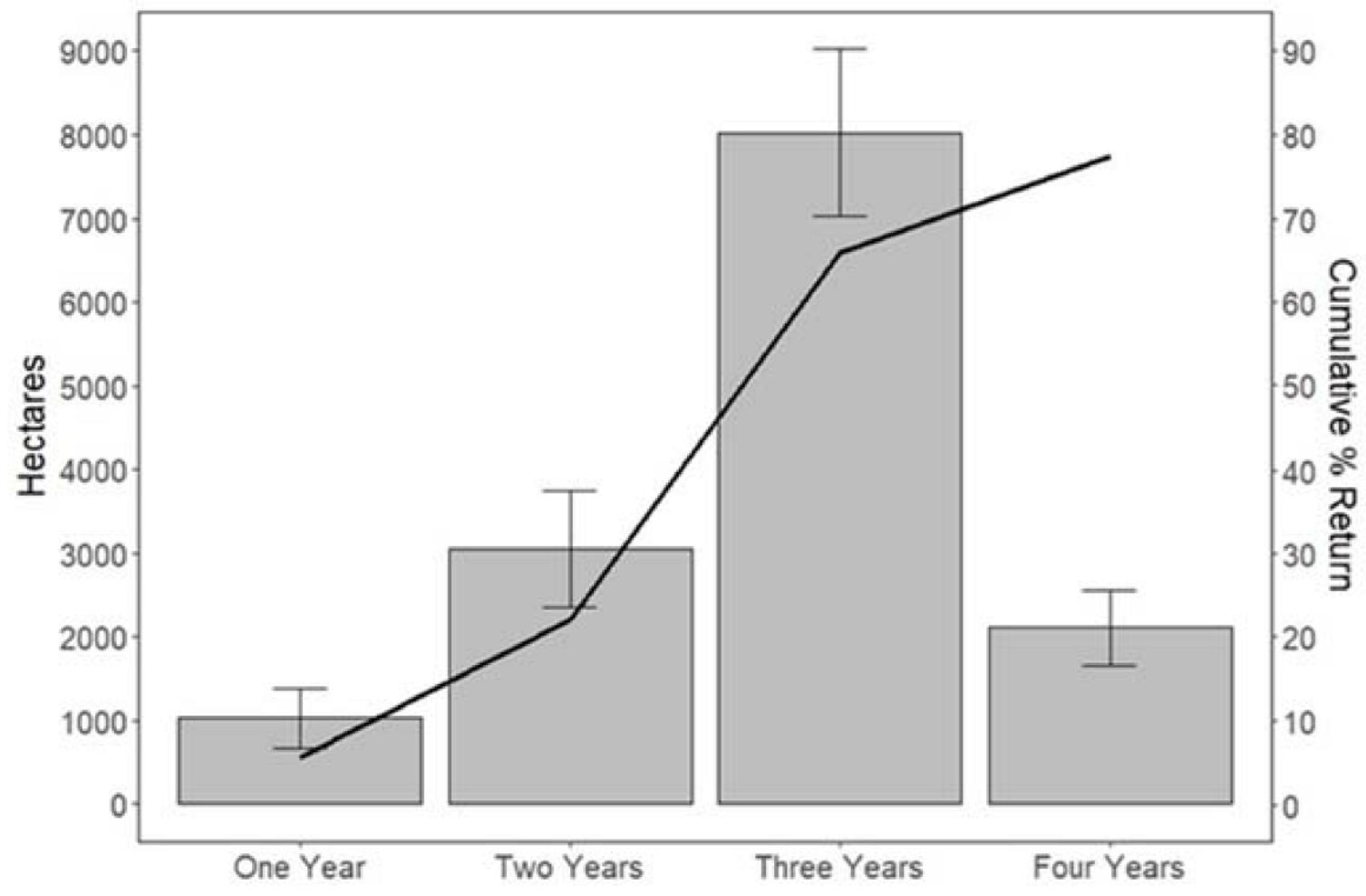Characterizing Dominant Field-Scale Cropping Sequences for a Potato and Vegetable Growing Region in Central Wisconsin
Abstract
:1. Introduction
2. Methods
2.1. Classification of Dominant Crop Types in Individual Fields
2.2. Classification of Multiyear Crop Rotations
2.3. Ecological Landscapes
3. Results
3.1. Crop Type Spatial Distributions, Area, and Frequency
3.2. Common Two- and Three-Year Rotations
3.3. Return Time to Potato and Most Common Rotations
4. Discussion
4.1. Spatial Distribution and Frequency of Common Crops Grown in the WCS Is Dictated by Soil Formation Processes
4.2. A High Number of Growers Use Multiple Year Rotations with Potato, but a Significant Fraction Return to Potato Immediately or by the Third Year
4.3. Changes in Continuous Corn Area and Increase in Soybean Reflect Changes in Energy Policy and Market Prices
5. Conclusions
Author Contributions
Funding
Institutional Review Board Statement
Informed Consent Statement
Data Availability Statement
Conflicts of Interest
References
- Laboski, C.A.M.; Peters, J.B. Nutrient Application Guidelines for Field, Vegetable, and Fruit Crops in Wisconsin Nutrient Application Guidelines for Field, Vegetable, and Fruit Crops in Wisconsin. 2012. Available online: http://corn.agronomy.wisc.edu/management/pdfs/a2809.pdf (accessed on 3 December 2021).
- Prunty, L.; Greenland, R. Nitrate leaching using two potato-corn N-fertilizer plans on sandy soil. Agric. Ecosyst. Environ. 1997, 65, 1–13. [Google Scholar] [CrossRef]
- Larkin, R.P.; Honeycutt, C.W.; Olanya, O.M.; Halloran, J.M.; He, Z. Impacts of Crop Rotation and Irrigation on Soilborne Diseases and Soil Microbial Communities. In Sustainable Potato Production: Global Case Studies; Springer: Berlin/Heidelberg, Germany, 2012; pp. 23–41. [Google Scholar] [CrossRef]
- Larkin, R.P. Crop Rotation and Soil Health in Potato Production Systems. Grow Plant Health Exch. 2019. [Google Scholar] [CrossRef]
- NASS. Vegetables 2019 Summary; USDA: Washington, DC, USA, 2020; pp. 1–101. [Google Scholar]
- Kraft, G.J.; Clancy, K.; Mechenich, D.J.; Haucke, J. Irrigation Effects in the Northern Lake States: Wisconsin Central Sands Revisited. Ground Water 2012, 50, 308–318. [Google Scholar] [CrossRef] [PubMed]
- Wisconsin Department of Natural Resources. The Ecological Landscapes of Wisconsin: An Assessment of Ecological Resources and a Guide to Planning Sustainable Management. In Central Sand Hills Ecological Landscape; Chapter 9; Wisconsin Department of Natural Resources: Madison, WI, USA, 2015. [Google Scholar]
- Kniffin, M.; Potter, K.; Bussan, A.; Colquhoun, J.; Bradbury, K. Sustaining Central Sands Water Resources: State of the Science. Master’s Thesis, University of Wisconsin-Madison, Madison, WI, USA, 2014; pp. 1–100. [Google Scholar]
- Kraft, G.J.; Mechenich, D.J.; Haucke, J. Information Support for Groundwater Management in the Wisconsin Central Sands, 2011–2013; Wisconsin Department of Natural Resources: Madison, WI, USA, 2014. [Google Scholar]
- Knuteson, D.L.; Groves, R.L.; Colquhoun, J.B.; Ruark, M.; Gevens, A.J.; Bussan, A.J. BioIPM Potato Workbook. Lit. Imagin. 2003, 5, 179. [Google Scholar] [CrossRef]
- Emmond, G.S.; Ledingham, R.J. Effects of crop rotation on some soil-borne pathogens of potato. Can. J. Plant Sci. 1972, 52, 605–611. [Google Scholar] [CrossRef] [Green Version]
- Frank, J.A.; Murphy, H.J. The effect of crop rotations on rhizoctonia disease of potatoes. Am. Potato J. 1977, 7, 541–559. [Google Scholar] [CrossRef]
- Pedersen, E.A.; Hughes, G.R. The Effect of Crop Rotation on Development of the Septoria Disease Complex on Spring Wheat in Saskatchewan. Can. J. Plant Pathol. 1992, 14, 152–158. [Google Scholar] [CrossRef]
- Scholte, K. The effect of crop rotation and granular nematicides on the incidence of Rhizoctonia solani in potato. Potato Res. 1987, 30, 187–199. [Google Scholar] [CrossRef]
- Huber, D.M.; Watson, R.D.; Steiner, G.W. Crop Residues, Nitrogen, and Plant Disease. Soil Sci. 1965, 100, 302–308. [Google Scholar] [CrossRef]
- Fry, W.E. Disease Management in Practice. Princ. Plant Dis. Manag. 1982, 303–329. [Google Scholar] [CrossRef]
- Bélair, G.; Dauphinais, N.; Fournier, Y.; Dangi, O.P.; Ciotola, M. Canadian Journal of Plant Pathology Effect of 3-year rotation sequences and pearl millet on population densities of Pratylenchus penetrans and subsequent potato yield. Can. J. Plant Pathol. 2006, 28, 230–235. [Google Scholar] [CrossRef]
- Rupp, J.; Jacobsen, B. Bacterial and Fungal Disease of Potato and Their Management; Montana State University Extension: Bozeman, MT, USA, 2017. [Google Scholar]
- Sill, W.H.J. Plant Protection, an Integrated Interdisciplinary Approach; Iowa State University Press: Ames, IA, USA, 1982. [Google Scholar]
- Honeycutt, C.W.; Clapham, W.M.; Leach, S.S. Crop rotation and N fertilization effects on growth, yield, and disease incidence in potato. Am. Potato J. 1996, 73, 45–61. [Google Scholar] [CrossRef]
- Peters, R.D.; Sturz, A.V.; Carter, M.R.; Sanderson, J.B. Developing disease-suppressive soils through crop rotation and tillage management practices. Soil Tillage Res. 2003, 72, 181–192. [Google Scholar] [CrossRef]
- Williams, L.E.; Schmitthenner, A.F. Effect of crop rotations on soil fungus populations. Phytopathology 1962, 52, 241–247. [Google Scholar]
- Peters, R.D.; Sturz, A.V.; Carter, M.R.; Sanderson, J.B. Influence of crop rotation and conservation tillage practices on the severity of soil-borne potato diseases in temperate humid agriculture. Can. J. Soil Sci. 2004, 84, 397–402. [Google Scholar] [CrossRef]
- Azzari, G.; Grassini, P.; Edreira, J.I.R.; Conley, S.; Mourtzinis, S.; Lobell, D.B. Satellite mapping of tillage practices in the North Central US region from 2005 to 2016. Remote Sens. Environ. 2019, 221, 417–429. [Google Scholar] [CrossRef]
- Noe, R.R. Uncertainty in Cropland Data Layer derived Land-Use Change Estimates: Putting Corn and Soy Expansion Estimates in Context. Master’s Thesis, University of Minnesota, Minneapolis, MN, USA, 2015. [Google Scholar]
- Yost, M.A.; Russelle, M.P.; Coulter, J.A.; Bolstad, P.V. Alfalfa Stand Length and Subsequent Crop Patterns in the Upper Midwestern United States. Agron. J. 2014, 106, 1697–1708. [Google Scholar] [CrossRef]
- Stern, A.J.; Doraiswamy, P.C.; Raymond Hunt, E. Changes of crop rotation in Iowa determined from the United States Department of Agriculture, National Agricultural Statistics Service cropland data layer product. J. Appl. Remote Sens. 2012, 6, 063590. [Google Scholar] [CrossRef]
- Long, J.A.; Lawrence, R.L.; Miller, P.R.; Marshall, L.A. Changes in field-level cropping sequences: Indicators of shifting agricultural practices. Agric. Ecosyst. Environ. 2014, 189, 11–20. [Google Scholar] [CrossRef]
- Lark, T.J.; Mueller, R.M.; Johnson, D.M.; Gibbs, H.K. Measuring land-use and land-cover change using the U.S. department of agriculture’s cropland data layer: Cautions and recommendations. Int. J. Appl. Earth Obs. Geoinf. 2017, 62, 224–235. [Google Scholar] [CrossRef]
- Johnston, C.A. Agricultural expansion: Land use shell game in the U.S. Northern Plains. Landsc. Ecol. 2014, 29, 81–95. [Google Scholar] [CrossRef]
- USDA-NASS. USDA—National Agricultural Statistics Service—Research and Science-CropScape and Cropland Data Layer-Announcements 2021. Available online: https://www.nass.usda.gov/Research_and_Science/Cropland/SARS1a.php (accessed on 22 June 2021).
- Wisconsin DNR. Central Sands Background and Outreach Resources. 2021. Available online: https://dnr.wisconsin.gov/topic/Wells/HighCap/CSLBackground.html (accessed on 2 August 2021).
- ESRI. ArcGIS Desktop: Release 10.7.1; ESRI: Redlands, CA, USA, 2019. [Google Scholar]
- Hennessy, D. On Monoculture and the Structure of Crop Rotations. Am. J. Agric. Econ. 2006, 88, 900–914. [Google Scholar] [CrossRef] [Green Version]
- Lark, T.J.; Meghan Salmon, J.; Gibbs, H.K. Cropland expansion outpaces agricultural and biofuel policies in the United States. Environ. Res. Lett. 2015, 10, 44003. [Google Scholar] [CrossRef] [Green Version]
- Wisconsin Department of Natural Resources. The Ecological Landscapes of Wisconsin: An Assessment of Ecological Resources and a Guide to Planning Sustainable Management; Wisconsin Department of Natural Resources: Madison, WI, USA, 2015. [Google Scholar]
- Wisconsin Department of Natural Resources. The ecological landscapes of Wisconsin: An assessment of ecological resources and a guide to planning sustainable management. In Central Sand Plains Ecological Landscape; Chapter 10; Wisconsin Department of Natural Resources: Madison, WI, USA, 2015. [Google Scholar]
- Wisconsin Department of Natural Resources. The ecological landscapes of Wisconsin: An assessment of ecological resources and a guide to planning sustainable management. In Forest Transition Ecological Landscape; Chapter 11; Wisconsin Department of Natural Resources: Madison, WI, USA, 2015. [Google Scholar]
- Wisconsin Department of Natural Resources. The ecological landscapes of Wisconsin: An assessment of ecological resources and a guide to planning sustainable management. In Southeast Glacial Plains Ecological Landscape; Chapter 18; Wisconsin Department of Natural Resources: Madison, WI, USA, 2015. [Google Scholar]
- Wisconsin Department of Natural Resources. The ecological landscapes of Wisconsin: An assessment of ecological resources and a guide to planning sustainable management. In Central Lake Michigan Coastal Ecological Landscape; Chapter 8; Wisconsin Department of Natural Resources: Madison, WI, USA, 2015. [Google Scholar]
- Kashian, R.; Depas, J.; Fogarty, P.; Peterson, J. Potato Production in Wisconsin: Analyzing the Economic Impact; University of Wisconsin-Whitewater: Whitewater, WI, USA, 2014. [Google Scholar]
- Kraft, G.J.; Browne, B.A.; Devita, W.M.; Mechenich, D.J. Nitrate and Pesticide Residue Penetration into a Wisconsin Central Sand Plain Aquifer; University of Wisconsin-Stevens Point: Stevens Point, WI, USA, 2004. [Google Scholar]
- Halloran, J.M.; Griffin, T.S.; Honeycutt, C.W. An economic analysis of potential rotation crops for Maine Potato cropping systems. Am. J. Potato Res. 2005, 82, 155–162. [Google Scholar] [CrossRef]
- Watkins, K.B.; Lu, Y.-C. Economic and environmental tradeoffs among alternative seed potato rotations. J. Sustain. Agric. 1998, 13, 37–53. [Google Scholar] [CrossRef]
- Rowberry, R.; Anderson, G. The profitability of continuous potatoes versus rotations including potatoes and other cash crops. Am. Potato J. 1983, 60, 503–510. [Google Scholar] [CrossRef]
- Li, R.; Monti, A. Land Allocation for Biomass Crops: Challenges and Opportunities with Changing Land Use; Springer International Publishing: Berlin/Heidelberg, Germany, 2018. [Google Scholar] [CrossRef]
- Lewandrowski, J.; Rosenfeld, J.; Pape, D.; Hendrickson, T.; Jaglo, K.; Moffroid, K. The greenhouse gas benefits of corn etha-nol-assessing recent evidence. Biofuels 2020, 11, 361–375. [Google Scholar] [CrossRef] [Green Version]
- CRS Report for Congress Biofuels Provisions in the 2007 Energy Bill and the 2008 Farm Bill: A Side-by-Side Comparison-name redacted-Specialist in Agricultural Policy-name redacted-Specialist in Energy and Environmental Policy. 2009. Available online: https://www.everycrsreport.com/reports/RL34239.html (accessed on 6 January 2021).
- Mallya, G.; Zhao, L.; Song, X.C.; Niyogi, D.; Govindaraju, R.S. 2012 Midwest Drought in the United States. J. Hydrol. Eng. 2013, 18, 737–745. [Google Scholar] [CrossRef]
- USDA-ERS. USDA ERS—U.S. Drought 2012: Farm and Food Impacts; USDA-ERS: Washington, DC, USA, 2015. [Google Scholar]
- Ferguson, B.J.; Indrasumunar, A.; Hayashi, S.; Lin, M.H.; Lin, Y.H.; Reid, D.E.; Gresshoff, P.M. Molecular analysis of legume nodule development and autoregulation. J. Integr. Plant Biol. 2010, 52, 61–76. [Google Scholar] [CrossRef]
- Hirel, B.; le Gouis, J.; Ney, B.; Gallais, A. The challenge of improving nitrogen use efficiency in crop plants: Towards a more central role for genetic variability and quantitative genetics within integrated approaches. J. Exp. Bot. 2007, 58, 2369–2387. [Google Scholar] [CrossRef]
- Peoples, M.B.; Brockwell, J.; Herridge, D.F.; Rochester, I.J.; Alves, B.J.R.; Urquiaga, S.; Boddey, R.M.; Dakora, F.D.; Bhattarai, S.; Maskey, S.L.; et al. The contributions of nitrogen-fixing crop legumes to the productivity of agricultural systems. Symbiosis 2009, 48, 1–17. [Google Scholar] [CrossRef]
- Canfield, D.E.; Glazer, A.N.; Falkowski, P.G. The evolution and future of earth’s nitrogen cycle. Science 2010, 330, 192–196. [Google Scholar] [CrossRef] [PubMed] [Green Version]
- Undersander, D.; Cosgrove, D.; Cullen, E.; Grau, C.; Rice, M.E.; Renz, M.; Sheaffer, C.; Shewmaker, G.; Sulc, M. Alfalfa Management Guide; American Society of Agronomy: Madison, WI, USA; Crop Science Society of America: Madison, WI, USA; Soil Science Society of America: Madison, WI, USA, 2011. [Google Scholar]
- Center for Watershed Science and Education. WI Well Water Viewer. 2019. Available online: https://www.uwsp.edu/cnr-ap/watershed/Pages/WellWaterViewer.aspx (accessed on 14 September 2021).





| Year | Corn | Alfalfa | Soybean | Sweet Corn | Potato | Beans | Cereal | Peas | Total |
|---|---|---|---|---|---|---|---|---|---|
| Hectares | |||||||||
| 2008 | 65,233 | 32,483 | 18,948 | 22,787 | 17,864 | 13,819 | 10,789 | 3788 | 185,711 |
| 2009 | 63,514 | 31,493 | 19,222 | 26,186 | 17,303 | 12,008 | 28,316 | 2909 | 200,950 |
| 2010 | 67,505 | 20,904 | 19,538 | 22,059 | 18,192 | 14,247 | 5476 | 3223 | 171,144 |
| 2011 | 75,228 | 22,706 | 20,308 | 19,603 | 18,146 | 12,411 | 4883 | 2860 | 176,144 |
| 2012 | 82,399 | 21,324 | 20,450 | 21,948 | 20,627 | 8309 | 2916 | 2020 | 179,993 |
| 2013 | 85,403 | 22,579 | 15,442 | 18,818 | 17,719 | 12,089 | 9925 | 3228 | 185,203 |
| 2014 | 74,858 | 24,738 | 22,927 | 19,510 | 18,316 | 17,347 | 11,727 | 4297 | 193,721 |
| 2015 | 68,212 | 24,480 | 24,722 | 17,053 | 18,078 | 11,519 | 8406 | 5442 | 177,912 |
| 2016 | 75,548 | 19,029 | 21,891 | 25,143 | 18,860 | 11,822 | 8507 | 4412 | 185,214 |
| 2017 | 60,439* | 17,517 | 27,401 | 20,915* | 19,141 | 12,199 | 6909 | 4143 | 168,664 |
| 2018 | 60,893* | 21,685 | 28,742 | 20,915* | 18,046 | 13,578 | 6644 | 4706 | 175,209 |
| 2019 | 68,158 | 22,551 | 23,631 | 16,045 | 18,715 | 14,219 | 5023 | 5275 | 173,617 |
| Average | 70,616 | 23,457 | 23,457 | 20,915 | 18,417 | 12,797 | 9127 | 3859 | 181,123 |
| St Dev | 8091 | 4472 | 3777 | 3304 | 859 | 2150 | 6586 | 1040 | 9481 |
| Crop | Mean Hectare | % Ag Land | St Dev | CV | Slope | R2 | p-value |
|---|---|---|---|---|---|---|---|
| Corn | 70,616 | 24.8% | 35,482.9 | 1.9901 | −323.0 | 0.0207 | 0.6554 |
| Alfalfa | 23,457 | 8.2% | 11,380.8 | 2.0611 | −797.1 | 0.4131 | 0.0242 |
| Soybean | 21,935 | 7.7% | 10,504.9 | 2.0881 | 770.8 | 0.5416 | 0.0064 |
| Sweet Corn | 20,915 | 7.3% | 9872.9 | 2.1184 | −405.2 | 0.2390 | 0.1068 |
| Potato | 18,417 | 6.5% | 8399.3 | 2.1927 | 67.2 | 0.7950 | 0.3746 |
| Beans | 12,797 | 4.5% | 5705.0 | 2.2432 | 56.4 | 0.0090 | 0.7699 |
| Cereal | 9127 | 3.2% | 5826.3 | 1.5665 | −741.5 | 0.1648 | 0.0106 |
| Peas | 3859 | 1.4% | 1185.5 | 3.2549 | 203 | 0.4955 | 0.1905 |
| Total | 181,123 | 63.5% |
| Rotations | Mean Hectare | % Ag Land | St Dev | CV | Slope | R2 | p-Value |
|---|---|---|---|---|---|---|---|
| CC | 37,673 | 13.2% | 6720.4 | 0.1784 | −791.2 | 0.1525 | 0.2351 |
| AA | 16,014 | 5.6% | 2541.2 | 0.1587 | −246.8 | 0.1037 | 0.3341 |
| SC | 15,031 | 5.3% | 3340.2 | 0.2222 | 703.5 | 0.4880 | 0.0168 |
| CS | 14,346 | 5.0% | 2714.9 | 0.1892 | 630.4 | 0.5931 | 0.0056 |
| ScPo | 8062 | 2.8% | 1159.0 | 0.1438 | −105.7 | 0.0915 | 0.3659 |
| PoSc | 5580 | 2.0% | 878.8 | 0.1575 | −169.2 | 0.4078 | 0.0344 |
| PoC | 5405 | 1.9% | 1014.9 | 0.1878 | 210.98 | 0.4754 | 0.0189 |
| ScSc | 5160 | 1.8% | 419.9 | 0.0814 | −44.31 | 0.1225 | 0.2913 |
| ScB | 4599 | 1.6% | 1298.7 | 0.2823 | −86.42 | 0.0487 | 0.5143 |
| CA | 4263 | 1.5% | 1127.3 | 0.2644 | 134.9 | 0.1576 | 0.2267 |
| AC | 4137 | 1.5% | 614.6 | 0.1485 | −45.54 | 0.0604 | 0.4664 |
| BPo | 3891 | 1.4% | 618.7 | 0.1590 | 57.43 | 0.0948 | 0.3570 |
| CB | 3663 | 1.3% | 800.9 | 0.2186 | 130.22 | 0.2908 | 0.0869 |
| BSc | 2970 | 1.0% | 588.4 | 0.1981 | −57.82 | 0.1062 | 0.3281 |
| Total | 130,801 | 45.9% |
| Rotations | Mean Hectare | % Ag Land | St Dev | CV | Slope | R2 | p-Value |
|---|---|---|---|---|---|---|---|
| CCC | 24,329 | 8.5% | 4076.3 | 0.1675 | −545.8 | 0.1643 | 0.2451 |
| CSC | 11,410 | 4.0% | 2184.4 | 0.1914 | 527.1 | 0.5337 | 0.0164 |
| AAA | 11,334 | 4.0% | 1818.3 | 0.1604 | 23.0 | 0.0015 | 0.9165 |
| CCS | 6638 | 2.3% | 2036.3 | 0.3067 | 150.0 | 0.0498 | 0.5356 |
| SCS | 6602 | 2.3% | 1426.4 | 0.2161 | 386.7 | 0.6739 | 0.0036 |
| SCC | 5119 | 1.8% | 1230.0 | 0.2403 | 15.7 | 0.0015 | 0.9157 |
| CAA | 3259 | 1.1% | 925.0 | 0.2838 | 181.0 | 0.3509 | 0.0712 |
| AAC | 3245 | 1.1% | 514.6 | 0.1586 | −36.0 | 0.0449 | 0.5566 |
| ACC | 2929 | 1.0% | 547.8 | 0.1870 | −98.6 | 0.2968 | 0.1034 |
| CCA | 2874 | 1.0% | 832.6 | 0.2897 | 139.0 | 0.2554 | 0.1362 |
| ScPoSc | 2749 | 1.0% | 369.6 | 0.1345 | −60.9 | 0.2492 | 0.1419 |
| ScBPo | 2050 | 0.7% | 712.9 | 0.3477 | −98.9 | 0.1764 | 0.2269 |
| ScScPo | 1847 | 0.6% | 315.4 | 0.1708 | −48.5 | 0.2167 | 0.1752 |
| ScPoB | 1756 | 0.6% | 586.7 | 0.3341 | −7.3 | 0.0014 | 0.9174 |
| PoBC | 1690 | 0.6% | 1316.4 | 0.7791 | 306.9 | 0.4982 | 0.0226 |
| PoCB | 1650 | 0.6% | 861.1 | 0.5218 | 255.1 | 0.8047 | 0.0004 |
| Total | 89,481 | 31.4% |
| Rotation | Mean Hectare | % One Year Off | St dev | CV | Slope | R2 | p-Value |
| PoScPo | 1450 | 47.5% | 445.8 | 0.3074 | −69.3 | 0.2215 | 0.1698 |
| PoCPo | 534 | 17.5% | 171.0 | 0.3203 | −10.6 | 0.0352 | 0.6035 |
| PoBPo | 481 | 15.8% | 163.4 | 0.3398 | −11.8 | 0.0475 | 0.5455 |
| Total | 2465 | 80.8% | |||||
| Rotation | Mean Hectare | % Two Years Off | St dev | CV | Slope | R2 | p-value |
| PoScScPo | 1017 | 12.7% | 535.6 | 1.8996 | −34.7 | 0.2733 | 0.1487 |
| PoScBPo | 865 | 10.8% | 465.3 | 1.8596 | −40.5 | 0.2811 | 0.1420 |
| PoBScPo | 854 | 10.7% | 465.2 | 1.8366 | −23.8 | 0.0788 | 0.4643 |
| PoCBPo | 810 | 10.1% | 560.3 | 1.4458 | 135.3 | 0.4537 | 0.0467 |
| Total | 3547 | 44.2% | |||||
| Rotation | Mean Hectare | % Three Years Off | St dev | CV | Slope | R2 | p-value |
| PoScBScPo | 342 | 16.2% | 190.5 | 1.7965 | 21.9 | 0.2294 | 0.2298 |
| PoBScBPo | 148 | 7.0% | 108.6 | 1.3606 | −22.3 | 0.2213 | 0.2395 |
| PoCCBPo | 126 | 6.0% | 86.4 | 1.4562 | 16.4 | 0.2120 | 0.2509 |
| Total | 616 | 29.2% |
Publisher’s Note: MDPI stays neutral with regard to jurisdictional claims in published maps and institutional affiliations. |
© 2022 by the authors. Licensee MDPI, Basel, Switzerland. This article is an open access article distributed under the terms and conditions of the Creative Commons Attribution (CC BY) license (https://creativecommons.org/licenses/by/4.0/).
Share and Cite
Heineman, E.M.; Kucharik, C.J. Characterizing Dominant Field-Scale Cropping Sequences for a Potato and Vegetable Growing Region in Central Wisconsin. Land 2022, 11, 273. https://doi.org/10.3390/land11020273
Heineman EM, Kucharik CJ. Characterizing Dominant Field-Scale Cropping Sequences for a Potato and Vegetable Growing Region in Central Wisconsin. Land. 2022; 11(2):273. https://doi.org/10.3390/land11020273
Chicago/Turabian StyleHeineman, Emily Marrs, and Christopher J. Kucharik. 2022. "Characterizing Dominant Field-Scale Cropping Sequences for a Potato and Vegetable Growing Region in Central Wisconsin" Land 11, no. 2: 273. https://doi.org/10.3390/land11020273
APA StyleHeineman, E. M., & Kucharik, C. J. (2022). Characterizing Dominant Field-Scale Cropping Sequences for a Potato and Vegetable Growing Region in Central Wisconsin. Land, 11(2), 273. https://doi.org/10.3390/land11020273






